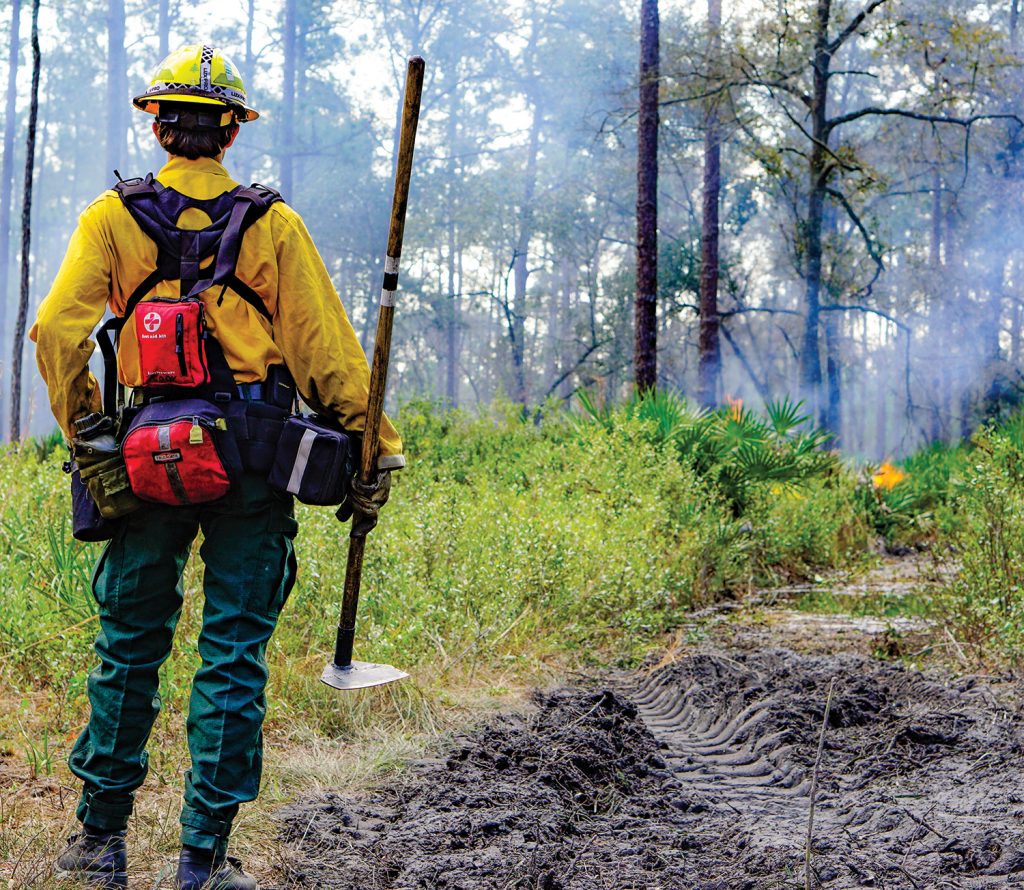By John Felsher
Periodically we see raging wildfires on the news. Some people have seen forest fires up close. Nobody wants to see trees burning, but a lot of good can come from a forest fire.
“There’s good fire and bad fire,” says John McGuire, a wildlife biologist from Auburn and the Alabama prescribed burn manager for Tall Timbers Research, a research and land conservancy group. “A good fire is one burned for very specific objectives, such as managing wildlife habitat. For the first week or two after a burn, the earth may look blackened and scorched, but quickly thereafter, everything starts to green back up and wildlife follows behind. I often seen turkey out the day after a fire burns. They might have young poults with them who need protein for feather development so they are in that blackened area looking for scorched insects. I’ve seen deer feeding in the middle of a burned area.”
For eons, forests across the Southeast depended upon fire to stay healthy. A prescribed fire under the right conditions for management purposes does considerable benefit. Many plants need periodic fires to survive. Some seeds only sprout after a fire. In addition, fire puts back nutrients into the soil. That encourages new plant growth.
“We have a very long history of burning in the Southeast, either from manmade fires or those that started naturally, like from lightning,” McGuire says. “Many native bean plants that are great food for wildlife thrive in burned over areas. They add atmospheric nitrogen back into the soil. Longleaf pines, the state tree of Alabama, become established on bare mineral soil created where fire recently passed through. Other tree species, like shortleaf pine, resprout vigorously following a fire. Pitcher plants and cane also do well in fire-dependent environments.”

Animals also depend upon fire. For instance, bobwhite quail need a ground disturbance to thrive. They require open ground beneath cover for rearing their young and canopies overhead to hide them from avian predators like hawks. When vegetation and ground clutter become too thick, small quail cannot get to their seeds to eat or move around easily.
McGuire described fire as “management by subtraction.” Fire clears out undesirable growth and eliminates ground debris. That opens the ground for new growth as more sunlight hits the dirt where thick vegetation formerly crowded out other plants. In bare dirt touched by sunlight, new sprouts shoot up. Deer, rabbits and other animals love to eat those succulent new shoots.
“People can burn habitat and manage a deer population quite well,” McGuire says. “Deer don’t eat pine straw. Through lack of burning, many forests just become shrubs, pine and pine needles with little food for deer. Fire manipulates not only the structure of the habitat, but also the food sources available for wildlife. With fire, we can create a mosaic of different food types for wildlife. I’ve seen native plants come back within a week after a fire.”
During a prescribed fire, most terrestrial animals like deer and rabbits simply move away from the danger and return afterwards. Birds and insects fly away. Frequently, birds perch at the edge of a fire waiting to snatch insects driven from cover by the flames. Arboreal animals like squirrels, raccoons and opossums can hide in tree holes.
“Very rarely are animals killed in a prescribed fire, especially big animals like deer,” McGuire says. “Most southern animals are well adapted to fire and run away. Turkeys run away. If a nest gets burned up, a turkey will renest. It’s the same with many other bird species. Gopher tortoises go in their burrows. Sometimes, a small animal might get trapped, but the benefits to the habitat overall is better for the species.”
People can’t just toss gasoline into some bushes, throw in a match and hope for the best. Some landowners break large tracts into smaller sections and only burn a fraction of it each year. Before starting a burn, land managers must develop a plan and apply for a burn permit from the Alabama Forestry Commission (forestry.alabama.gov).
Fortunately, landowners can find help from many state, federal and private sources like such conservation groups as Quail Forever, quailforever.org, or the National Wild Turkey Federation, nwtf.org. Most such groups can offer technical advice. Some might even provide funding assistance.
For starters, contact the nearest Alabama Department of Conservation and Natural Resources wildlife office or visit outdooralabama.com For Tall Timbers Research, call 850-893-4153 or visit talltimbers.org.
John N. Felsher is a professional freelance writer who lives in Semmes, Ala. He also hosts an outdoors tips show for WAVH FM Talk 106.5 radio station in Mobile, Ala. Contact him at [email protected] or through Facebook.




